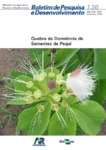Use este identificador para citar ou linkar para este item:
http://www.infoteca.cnptia.embrapa.br/infoteca/handle/doc/569162Registro completo de metadados
| Campo DC | Valor | Idioma |
|---|---|---|
| dc.contributor.author | PEREIRA, A. V. | pt_BR |
| dc.contributor.author | PEREIRA, E. B. C. | pt_BR |
| dc.contributor.author | SILVA, D. B. da | pt_BR |
| dc.contributor.author | GOMES, A. C. | pt_BR |
| dc.contributor.author | SOUSA-SILVA, J. C. | pt_BR |
| dc.date.accessioned | 2011-07-08T11:47:46Z | - |
| dc.date.available | 2011-07-08T11:47:46Z | - |
| dc.date.created | 2006-01-10 | pt_BR |
| dc.date.issued | 2004 | pt_BR |
| dc.identifier.citation | Planaltina, DF: Embrapa Cerrados, 2004. | pt_BR |
| dc.identifier.uri | http://www.infoteca.cnptia.embrapa.br/infoteca/handle/doc/569162 | pt_BR |
| dc.description | RESUMO: O objetivo deste trabalho foi avaliar os efeitos do tempo de imersão e da concentração de ácido giberélico na quebra de dormência das sementes de diferentes matrizes de pequi. Consistiu em dois experimentos conduzidos em safras distintas: no primeiro, os caroços oriundos da mistura de várias plantas foram submetidos à imersão por dois e quatro dias, em três concentrações de GA3 (0,500 e 1000 mg.dm³). O delineamento experimental foi inteiramente ao acaso, com oito repetições de 50 sementes por parcela, em esquema fatorial 3x2, mais a testemunha constituída de caroços não tratados. O segundo foi conduzido na safra seguinte, sendo os caroços colhidos e mantidos separados por planta-matriz (sete ao todo) e submetidos à imersão por dois e quatro dias em cinco concentrações de GA3 (0, 62,5, 125, 250 e 500 mg.dm-30) mais a testemunha composta de caroços não tratados. O delineamento experimental foi em blocos ao acaso, em esquema fatorial 5x2 + 1, utilizando 25 sementes por parcela. O tratamento com GA3 promoveu a quebra parcial da dormência das sementes de pequi, obtendo-se maior emergência de plântulas com a imersão dos caroços por dois a quatro dias nas concentrações de 125 a 500 mg.dm-3. A taxa de germinação de pequi variou entre as matrizes estudadas. ABSTRACT: This work consisted of two trials and it was carried out with the objective to investigate the dormancy and germination of the pequi seeds. The mature fruits were collected from the Brazilian savannah native plants, after falling down on the ground. The kernels were extracted from the fruits and maintained under shade for a week. The rot pulp was removed by means of a strong water flow and the keernels (still covered by the hard endocarp fruit) were dried under the sun for two hours and then left in the shade for a week. In the first trial, the kernels mixture from many plants was immerged for two and four days into three giberelic acid (GA3) solutions (0; 500 and 1000 mg.dm-3 of water). The experimental design was completely randomized, with 8 replicates of 50 seeds per plot, in a factorial scheme 2x3 plus the control (non-treated seeds). In the second trial, one year later, the fruits were collected by mother plant (seven at all) and treated as previous one. The kernels on each plant were immerged for two and four days into five GA3 solutions (0; 62,5; 125; 250 and 500 mg.dm-3 of water). The experimental design was completely randomized, with 8 replicates of 50 seeds per plot, in a factorial scheme 2x3 plus the control (non-treated seeds). In the second trial, one year later, the fruits were collected by mother plant (seven at all) and treated as previous one. The kernels of each plant were immerged for two and four days into five GA3 solutions )0; 62,5; 125; 250 and 500 mg.dm-3). The experimental design was completely randomized, in factorial scheme 5x2 plus the control (non-treated seeds), utilizing 25 kernels per plot. In both the trials, the kernels were sown in sand seed bed, and covered by a layer of vermiculite (about 1 cm thick). The percentage of seedling emergence was evaluated until the 90 days after sowing. The data were subjected the both variance and polynomial analyses and the means were compared by the Tukey test. The treatment with GA3 was partially efficient to break the pequi seed dormancy, obtaining seedling emergence varying from 22 % to 52 % depending on the mother plants. Higher percentage of seedling emergence were observed when the kernels were immerged in to GA3 solutions varying from 125 to 500 mg.dm-3, for two four days. | pt_BR |
| dc.language.iso | por | pt_BR |
| dc.relation.ispartofseries | (Embrapa Cerrados. Boletim de Pesquisa e Desenvolvimento, 136) | pt_BR |
| dc.rights | openAccess | pt_BR |
| dc.subject | Fruta nativa | pt_BR |
| dc.subject | Indigenous organisms | pt_BR |
| dc.subject | Emergence | pt_BR |
| dc.subject | GA | pt_BR |
| dc.title | Quebra da dormência de sementes de pequi. | pt_BR |
| dc.type | Folhetos | pt_BR |
| dc.date.updated | 2011-07-08T11:47:46Z | pt_BR |
| dc.subject.thesagro | Ácido Giberélico | pt_BR |
| dc.subject.thesagro | Caryocar Brasiliense | pt_BR |
| dc.subject.thesagro | Cerrado | pt_BR |
| dc.subject.thesagro | Emergência | pt_BR |
| dc.subject.thesagro | Germinação | pt_BR |
| dc.subject.thesagro | Pequi | pt_BR |
| dc.subject.thesagro | Semente | pt_BR |
| dc.subject.nalthesaurus | fruits | pt_BR |
| dc.subject.nalthesaurus | germination | pt_BR |
| dc.subject.nalthesaurus | seeds | pt_BR |
| dc.format.extent2 | 15 p. | pt_BR |
| riaa.ainfo.id | 569162 | pt_BR |
| riaa.ainfo.lastupdate | 2009-10-27 | pt_BR |
| Aparece nas coleções: | Boletim de Pesquisa e Desenvolvimento (CPAC)  | |
Arquivos associados a este item:
| Arquivo | Descrição | Tamanho | Formato | |
|---|---|---|---|---|
| bolpd136.pdf | 199,66 kB | Adobe PDF |  Visualizar/Abrir |









